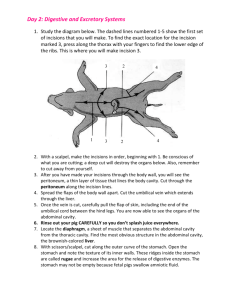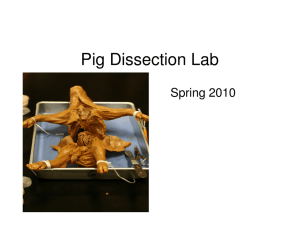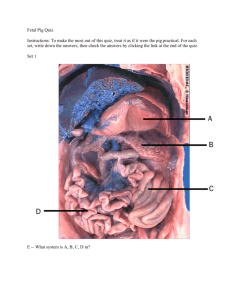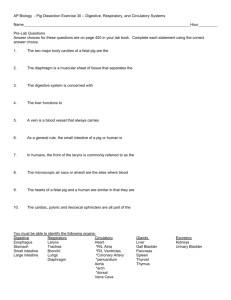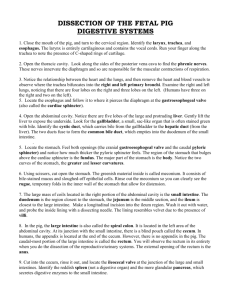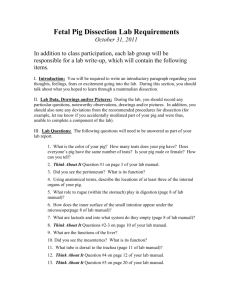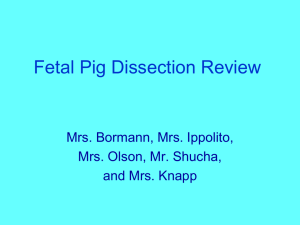Name Period Date - Brookwood High School
advertisement
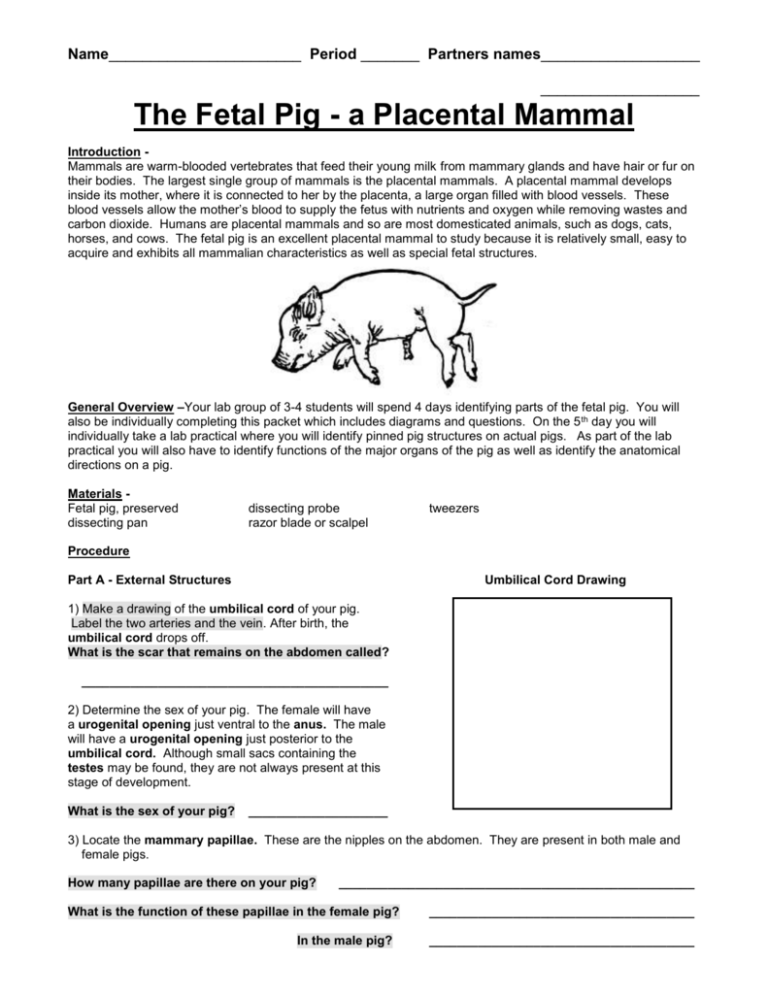
Name_______________________ Period _______ Partners names___________________ ___________________ The Fetal Pig - a Placental Mammal Introduction Mammals are warm-blooded vertebrates that feed their young milk from mammary glands and have hair or fur on their bodies. The largest single group of mammals is the placental mammals. A placental mammal develops inside its mother, where it is connected to her by the placenta, a large organ filled with blood vessels. These blood vessels allow the mother’s blood to supply the fetus with nutrients and oxygen while removing wastes and carbon dioxide. Humans are placental mammals and so are most domesticated animals, such as dogs, cats, horses, and cows. The fetal pig is an excellent placental mammal to study because it is relatively small, easy to acquire and exhibits all mammalian characteristics as well as special fetal structures. General Overview –Your lab group of 3-4 students will spend 4 days identifying parts of the fetal pig. You will also be individually completing this packet which includes diagrams and questions. On the 5 th day you will individually take a lab practical where you will identify pinned pig structures on actual pigs. As part of the lab practical you will also have to identify functions of the major organs of the pig as well as identify the anatomical directions on a pig. Materials Fetal pig, preserved dissecting pan dissecting probe razor blade or scalpel tweezers Procedure Part A - External Structures Umbilical Cord Drawing 1) Make a drawing of the umbilical cord of your pig. Label the two arteries and the vein. After birth, the umbilical cord drops off. What is the scar that remains on the abdomen called? ____________________________________________ 2) Determine the sex of your pig. The female will have a urogenital opening just ventral to the anus. The male will have a urogenital opening just posterior to the umbilical cord. Although small sacs containing the testes may be found, they are not always present at this stage of development. What is the sex of your pig? ____________________ 3) Locate the mammary papillae. These are the nipples on the abdomen. They are present in both male and female pigs. How many papillae are there on your pig? ___________________________________________________ What is the function of these papillae in the female pig? In the male pig? ______________________________________ ______________________________________ 4) CAUTION: Dissecting implements are very sharp. Use extreme caution. Using your scissors, cut the corners of the jaw so that the mouth will remain open. Take special care not to cut or damage any structures you will need to identify. Locate the following structures and label them on Diagram 1. tongue teeth nasopharynx glottis epiglottis hard palate soft palate salivary glands opening of the esophagus Diagram 1 - Mouth Parts 5) Using diagrams at your lab station, label all the parts of the pig on Diagram 7. Diagram 7 is located at the back of the dissection packet. You will need to be familiar with the location of these major parts prior to beginning the internal dissection tomorrow. 6) On Diagram 2, label the anatomical directions of the pig. Diagram 2 – Anatomical Directions Part B: Preparing for Dissection 1) You will be dissecting and observing the internal organs system by system. DO NOT REMOVE ANY ORGAN UNLESS YOU ARE ASKED TO BY YOUR INSTRUCTOR. Take care not to damage any structures when locating and dissecting other structures. Also, remember that no system functions alone. It is important to be aware of how each system relates to the others. 2) Place your pig in the dissecting pan, ventral side up. Diagram 3 - Incisions 3) Begin the dissection of the abdominal cavity by making cuts with your razor blade or scissors as shown in diagram 3. Cut through the skin and muscle tissue, but be aware of the depth of your blade, so as not to injure the underlying organs. Peel the skin back as you can so you can better see what you are cutting. NOTICE that you will be cutting around the umbilical cord but not detaching it. It will be best to use the scissors to cut the skin on the chest cavity because you will also be cutting through the soft breastbone and the ribs. Using the scissors, carefully cut the diaphragm on either side of the body, and fold it back over the liver. After making all the cuts, pin back the flaps of skin and tissue (except umbilical cord) to expose the coelomic cavity (abdominal) and the thoracic cavity. You may need to use the tweezers or probe to carefully detach skin flaps from the internal tissues. 4) Study the diagrams so that you will be able to locate all the structures printed in bold. Part C: The Digestive System 1) Follow the large vein at the base of the umbilical cord. Where does it go? ___________________________ Cut the vein so that the flap of skin with the umbilical cord can be turned back. 2) Below is an explanation of the structures to locate and observe in the abdominal cavity. Use Diagram 7 as a reference to locate structures a) Find the large, three lobed liver at the anterior end of the abdominal cavity. b) Under the liver is the stomach, a large pouch like organ with two parts. The large anterior end is the cardiac stomach and the smaller end is the pyloric stomach. Why is the anterior end of the stomach called the cardiac stomach? ________________________________ c) The point at which the stomach and the small intestine meet is called the pyloric sphincter. What is a sphincter? (p.980)_________________________________________________________________ d) Posterior to the sphincter is the small intestine. Follow it to where it enlarges to become the large intestine or colon. In some cases it is difficult to tell the difference between the two sections of the intestine. The difference is that the large intestine is slightly larger in diameter and has a small, blind pouch called the ceacum. The ceacum ends in the appendix in humans and in the pig. Closely observe the membranous, netlike tissue that can be found over the intestines. This is the mesentary. What is the function of the mesentary? ________________________________________________________ e) the large intestine continues and enlarges, forming the rectum. The point at which the rectum opens to the outside of the body is the anus. f) Relocate the liver. Lift it up and trace the stomach anteriorly to the esophagus. Why does the esophagus appear to be so short? ________________________________________________ g) Observe the dome-shaped muscular wall at the most anterior end of the abdominal cavity just above the liver. This is the diaphragm. It may be difficult to locate because you cut through it in Part B when you initially opened up the abdominal cavity. To what systems does the diaphragm belong? __________________________________________________ h) Embedded in the underside of the right central lobe of the liver is the greenish gall bladder. Locate it and then find and trace the bile duct, a small tube like structure that is attached to the gall bladder. Directly below the gallbladder on the underside of the stomach you will find a granular looking organ, the pancreas. Both the gall bladder and the pancreas release enzymes through a duct into the small intestine to aid in digestion. Attached to the left edge of the stomach is a reddish, smooth organ. This is the spleen. To what system does the spleen belong? (p.955,fig 37-12)_________________________________________ What is the function of the spleen? (p.955)______________________________________________________ Part D: The Respiratory and Circulatory Systems 1) Beginning at the top of the stomach, trace the esophagus as it passes through the diaphragm and under the heart. At the anterior end of the esophagus on the ventral side is the trachea. Notice the rings of cartilage that surround the trachea. What is the function of these rings of cartilage?(p.956)____________________________________________ These rings give the trachea the appearance of a vacuum cleaner hose. Trace the trachea to the point at which it branches to each lung. 2) Continue the dissection of the neck anteriorly to find an enlarged area of cartilage. This is the larynx, often called the voice box. At the top of the trachea is the epiglottis, which you located while observing the mouth structures on day 1. What is the function of the epiglottis? (p.956)____________________________________________________ 3) Using Diagram 7 as a reference locate the following - right lung, left lung, heart, and pericardium. What does the pericardium do? (P.944)_________________________________________________________ 4) Complete Diagram 4.(pp. 944-45) Use the word bank provided for you on separate sheet of paper. 5) Make sure Diagram 4 is complete before continuing. Carefully remove the pericardium from the heart. Using Diagram 4 as a guide, locate the following structures on the ventral side of the heart: right atrium, left atrium, right ventricle, left ventricle, coronary blood vessels. What is the function of the coronary blood vessels? _____________________________________________ 6) Turn the heart onto the dorsal side without removing it. Locate the two major veins that bring blood back to the heart, the superior vena cave and inferior vena cava. Locate the right and left pulmonary veins. This is the pair of veins that brings blood back to the heart from the lungs. Both of these empty into the left atrium. Which side of the heart has oxygenated blood? _________________________________________________ 7) Carefully dissect around the heart, picking away the connective tissue between the blood vessels. On the ventral side of the heart locate the pulmonary artery as it leaves the right ventricle. The aorta, the largest and most important artery, can be found just beneath the pulmonary artery as it leaves the left ventricle. Where does the left ventricle pump blood to? ___________________________________________________ Diagram 4 - Ventral & Dorsal views of the Heart Diagram 5 – Male Urogenital System Part E: The Urogenital System 1) Complete Diagrams 5 & 6. Use the word bank provided for you on separate sheet of paper. 2) The organs of the excretory and reproductive systems are located in the abdominal cavity. In order to see them you will need to move other organs out of the way. Take special care not to remove or damage any of the other organs. Make sure you have completed Diagram 5 and Diagram 6 before proceeding with dissection. You will be responsible for knowing the reproductive organs of both sexes. However, you need to concentrate on your pig initially. The kidneys are the pair of dark, bean shaped organs lying on the dorsal wall, behind the peritoneum. The kidneys are supplied with blood by the renal arteries. The renal veins take blood away from the kidneys. They are located just below the renal arteries. 3) Coming from the posterior end of the kidney is the ureter. This is the tube that drains urine from the kidney into the urinary bladder for storage. Trace the ureter to the bladder. Locate the urethra, which comes from the urinary bladder to the urogenital opening, through which the urine is eliminated from the body. 4) The Male Reproductive system: Depending on the age of the male fetus you will find the oval-shaped testes either in the abdominal cavity or inside the scrotal sacs at the posterior of the pig. On each testis find the coiled epididymis. What is the function of the epididymis? (p.1010)_________________________________________________ The vas deferens carry the sperm from the epididymis to the urethra. Follow the urethra to the penis, a muscular tube carrying both reproductive cells and liquid wastes out of the body. The urethra goes all the way through the inside of the penis. 5) The Female Reproductive system: Locate the two ovaries at the posterior end of the abdominal cavity of the female fetus. Each ovary has a coiled, tube like structure called the oviduct. What is the function of the oviduct (fallopian tubes)? (p. 1013)_____________________________________ Trace the path of the oviduct to the uterus where the fertilized egg develops into an embryo and later into a fetus. The muscular tube just posterior to the uterus is the vagina. In the pig the vagina opens into an area called the urogenital sinus that opens to the outside of the body through the urogenital opening, just ventral to the anus. F. Dissection Review – to help prepare for lab practical 1) Make sure that you and your partner(s) can identify the following parts on your pig. 2) For the lab practical you will need to be familiar with the function of the structures that are in bold on list below. In the extra space below write the function of each of the structures in bold. 3) be familiar with diagram 2 – anatomical directions External Parts umbilical cord urogenital opening (male & female) mammary papillae Mouth Parts tongue nasopharynx epiglottis hard palate soft palate opening of esophagus Internal Parts liver stomach small intestine large intestine mesentary esophagus diaphragm gall bladder pancreas spleen trachea larynx lungs heart pericardium aorta kidneys ureters urinary bladder urethra ovary oviduct Diagram 6 - Female Urogenital System Analysis and Conclusion 1) Name the major mammalian characteristics that are exhibited by the fetal pig. (p.1071) 2) Name the organs and structures of the digestive system in the order that food moves through them. (p.979) 3) What other organs and structures are part of the digestive system? (p. 978) 4) Name the organs and structures of the respiratory system in order, from the mouth to the alveoli. (p. 957) 5) Name the blood vessels and heart structures that make up the circulatory system in order, beginning with the superior vena cava and inferior vena cava. (pp. 944-45) Diagram 7 - Major Internal Parts
